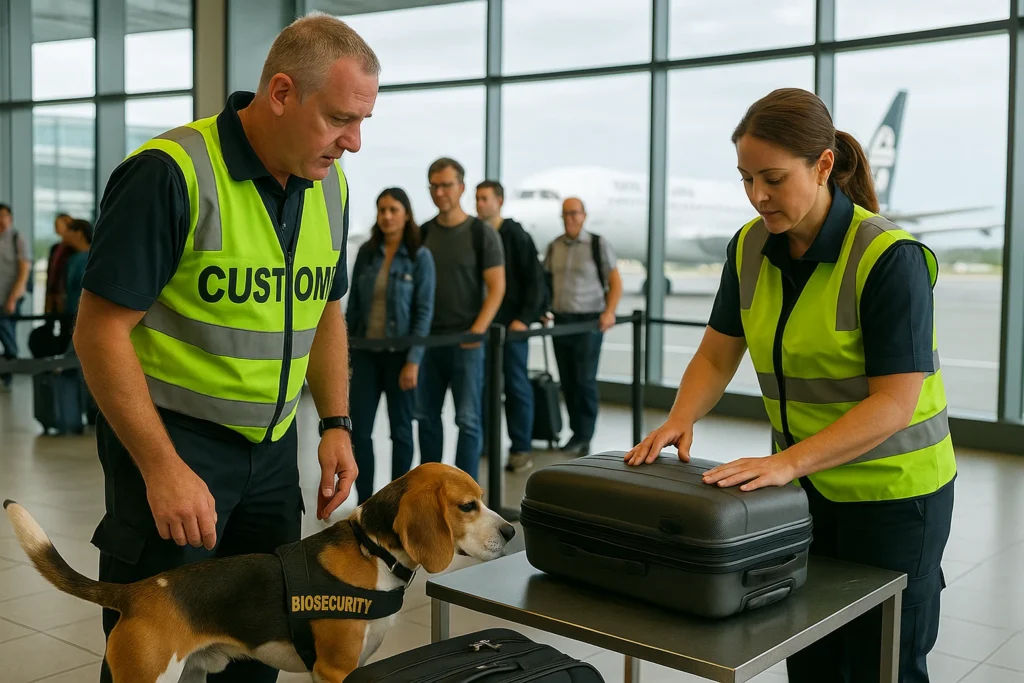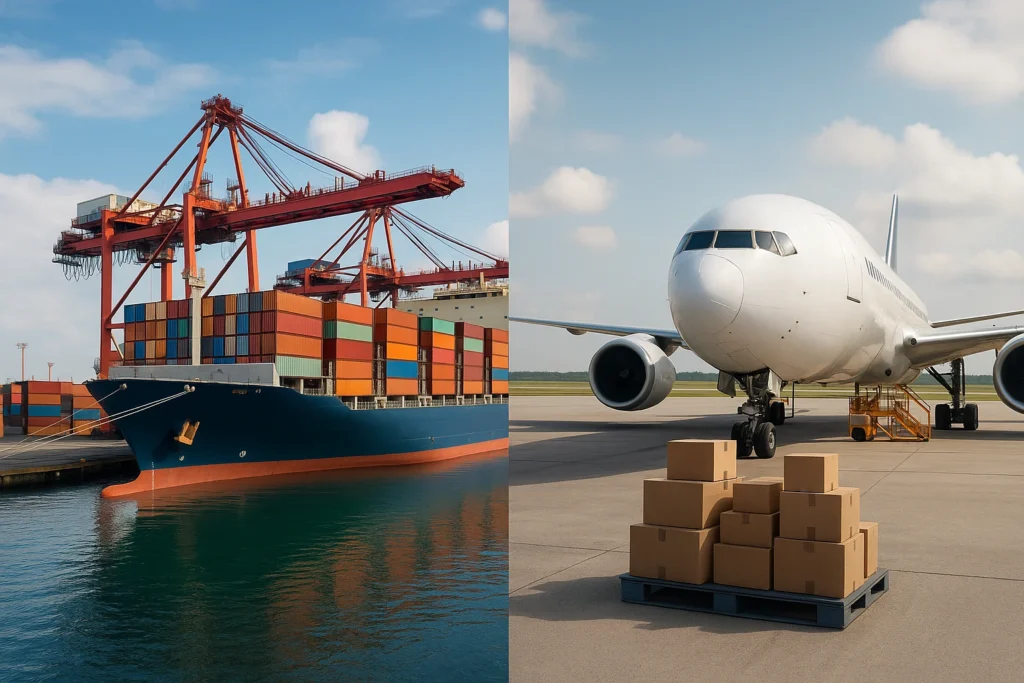Movers won’t tell you about the hidden fees that appear after you’ve signed the contract. Let’s be honest, the advertised shipping rates look affordable at first. Then, customs duties appear on your bill, and biosecurity inspections add charges you didn’t budget for.
Fuel surcharges, insurance costs, and taxes all pile on later. Some companies charge extra if you live outside major cities or need weekend delivery. These add-ons can significantly increase your total cost.
This article gives you honest advice about postage costs, delivery times, and restricted items. You’ll learn how to pick the right shipping method and handle NZ customs without surprises.
Follow along to discover everything about shipping timelines, customs rules, and choosing the right method for your move.
How Long Does Shipping from Brisbane to NZ Take?
Delivery times from Australia to New Zealand aren’t set in stone. Your shipping method plays a huge role, and so does your final destination. For example, sea freight takes longer but won’t drain your wallet. On the flipside, air freight gets your belongings there quickly, though you’ll pay more for the speed.
Here’s what each option looks like:
- Sea Freight: Containers from Brisbane usually arrive in New Zealand within two to three weeks. Plus, customs clearance can add another week because of biosecurity officers. Look at the bright side, you get extra time to sort out accommodation and handle paperwork before everything shows up.
- Air Freight: Using this method, your parcels reach major cities in three to five days. So, if you need something urgently, we recommend you choose air delivery. Rural areas take longer because couriers travel further from the airport to reach you.
- What Slows Things Down: Customs checks eat up time regardless of which method you pick. You’ll face extra delays if biosecurity officers need to inspect equipment, clothing, or anything that might carry organisms from overseas. The problem gets worse during December and January when freight services struggle to handle the holiday rush.
Realistic expectations about delivery speeds save you from stressing out when your shipment takes longer than the initial estimate suggested.
What You Can’t Bring to NZ

New Zealand doesn’t mess around with biosecurity. You are aware that customs officers stop restricted items every day, but they’re not doing it to annoy you. The truth is, the country has unique ecosystems that could be destroyed by foreign pests and diseases. That’s why the rules at the border stay strict for a reason.
You don’t want to be the person watching officials confiscate your belongings because you didn’t check the prohibited list first. Fines and delays pile up fast when you bring the wrong items.
Here’s what usually causes problems:
Food and Plant Products
Fresh fruit won’t make it past customs. Neither will vegetables, seeds, or live plants. Honey gets stopped too, along with nuts and dried herbs. Even your favourite packaged snacks might get flagged if they contain ingredients on the prohibited list.
Besides, foreign pests love hiding in food. One piece of contaminated fruit could carry insects or diseases that devastate Zealand’s farms and native species. Officers take this seriously because the risks are real, not theoretical.
Animal Products and Medications
Raw meat and processed animal products face heavy restrictions. Your prescription medications might need special permits, particularly if they contain controlled substances. Fishing rods get extra attention too, especially if they touched water or soil overseas.
Note that parasites and organisms cling to wet gear for weeks. Officers know this, so they check equipment carefully before letting it through. We suggest you carry cleaning certificates to make the whole process faster and prove you’ve taken precautions.
Other Surprising Restrictions
Decorative weapons from your trip need documentation before customs will approve them. Your hiking boots and camping gear will likely be inspected if they appear muddy or worn. Alongside that, used clothing and footwear attract attention because dirt sticks to fabric and soles easily.
Take Microscopic pests, for instance, they hide in soil particles. Zealand hasn’t dealt with many of these organisms before, so introducing them could cause serious environmental damage. Basically, officers check anything that might carry foreign dirt for this exact reason.
You’ll avoid headaches if you know what to leave at home. Next, you have to know how to handle customs paperwork without confusion.
Getting Through NZ Customs

Customs paperwork stresses people out, but it doesn’t have to be complicated. New Zealand now uses the New Zealand Traveller Declaration system to make entry requirements simpler. You can fill out the digital declaration through the NZTD app before you even board your flight. The app walks you through four easy steps that cover what you’re bringing into the country.
If you prefer paper, customs officials still accept the paper declaration form when you arrive. Either way, you need to be honest about what you’ve declared. Bear in mind, officers check randomly, and lying about restricted items leads to serious fines.
So, your documents must include proof of ownership for expensive equipment and receipts for any items purchased overseas. Because customs uses this information to calculate duties and taxes. Besides, commercial shipments require extra paperwork, so business imports take longer to clear than personal belongings.
With customs sorted, it’s time to pick the shipping method that fits your situation.
Choosing Your Shipping Method

Now that you know how to handle customs, you need to figure out which shipping method truly works for your move. The option you pick affects your costs and when your belongings arrive.
Here’s how the main shipping options compare:
Sea Freight
Sea freight makes the most sense when you’re moving furniture, appliances, and heaps of personal belongings. That’s because sea containers can hold a massive amount of stuff without breaking your budget.
You’ve got two choices here.
Shared containers let you split costs with other customers shipping to NZ, which keeps expenses low. On the other hand, exclusive containers cost more upfront, but your items arrive faster. With the second option, you won’t have to worry about someone else’s boxes damaging your belongings during transit.
Air Freight
Air freight suits you better if you need smaller loads delivered quickly. In a nutshell, your parcels reach NZ in days rather than weeks, which helps when you need certain equipment or documents urgently.
The trade-off hits your wallet hard, though. Air services charge significantly higher rates per kilogram than sea options, so save this method for items you genuinely can’t wait for.
Tracking Options
Good shipping companies give you online tracking from start to finish. You’ll know exactly where your stuff is at any point during transit. Most services running between Australia and NZ operate on regular schedules and reach both major cities and remote areas.
Before you commit to any shipping company, free quotes allow you to compare prices. This scope enables you to find a reliable operator who guarantees their delivery windows. Doing this helps you plan around when your shipment lands.
Picking the right method takes some of the stress out of moving, but having professional help makes the whole process smoother.
Your Smooth Move to NZ Starts Here
Your move to NZ gets easier when you understand the real costs, realistic timelines, and customs requirements. The information in this article helps you avoid the common mistakes people make when shipping internationally.
Professional movers like Ikku make the whole process smoother. We handle packing, customs paperwork, and delivery so you can focus on settling into your new life. Our team has moved countless families and businesses to New Zealand over the years.
What’s more, full insurance coverage protects your belongings from start to finish.
Are you ready to plan your move? Get in touch with us to set up a consultation. We’ll walk you through the best shipping options and provide a clear quote.
